History is not simply a series of random events. Every event that has occurred in human history is part of a continuous timeline, influenced by the events that preceded it and shaping those that would come after. The historical timeline is an incredibly valuable way to visualize this flow of events and understand the context of different eras in relation to one another.
In this comprehensive guide, we will introduce you to the importance and details of historical timelines, how you can create one, and how to use Boardmix templates to make this process even more efficient and engaging.
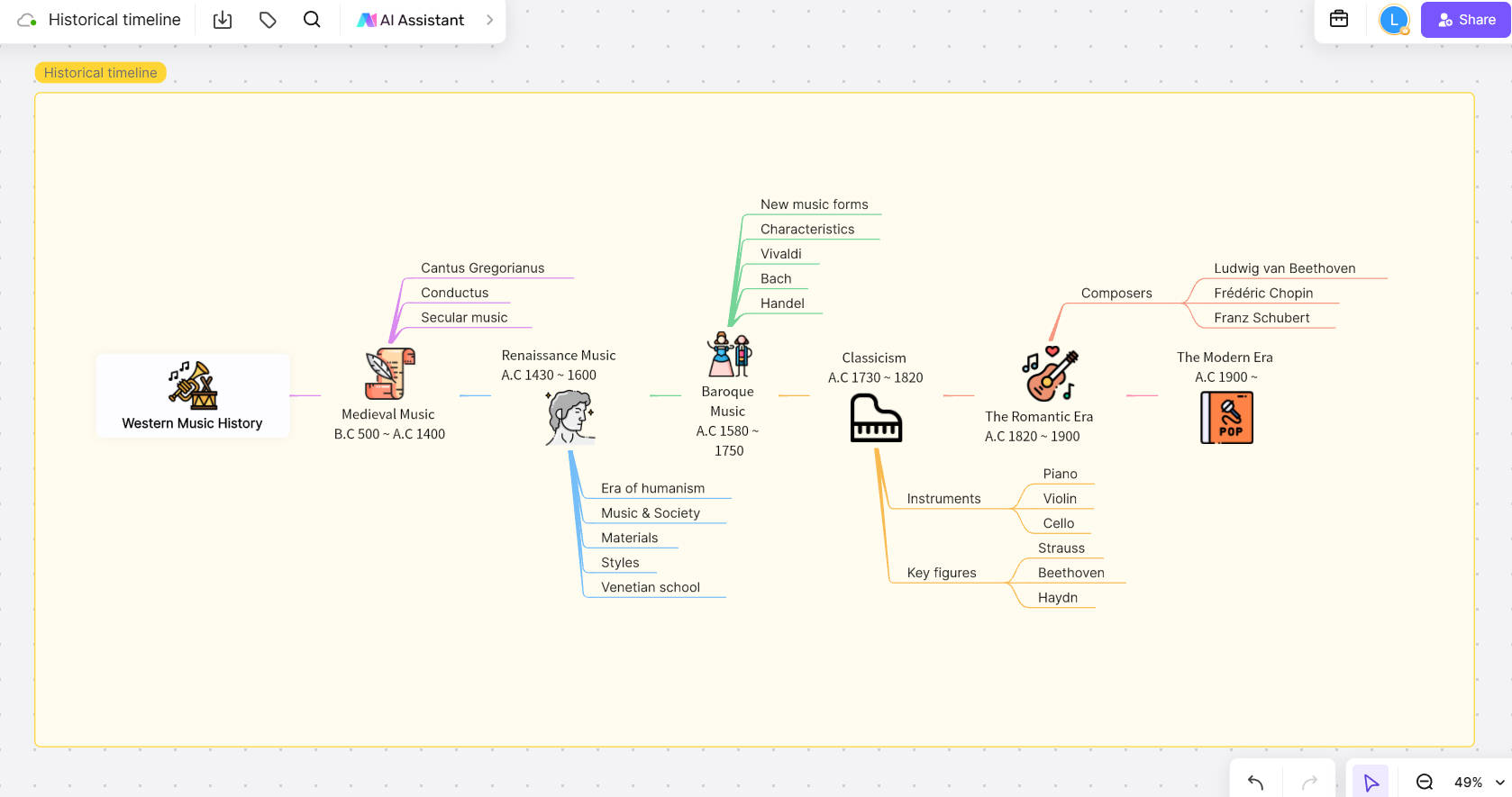
Create a historical timeline on Boardmix
What is a Timeline?
A timeline is a graphical representation of a sequence of events, arranged chronologically along a straight or curved line. This line can be vertical or horizontal. As you can see in the historical timeline Boardmix template below, each event on the timeline is represented as a point or segment on the line, and is labeled with a specific description or date. Timelines are useful for visualizing historical events, step-by-step processes, developments in a project, and any other sequence of events that occur over time.
Timelines are essential in the study of history as they provide a time frame within which historical events can be understood. They allow us to clearly and orderly visualize events that have occurred over time. Instead of having a bunch of dates and facts scattered around in our minds, the timeline helps us organize this data into a coherent and easy-to-understand format.
In addition, the timeline is an invaluable tool for understanding causal relationships between different historical events. For example, we can see how one particular event led to another, or how several events combined to produce a specific outcome. This helps us better understand the flow of history and predict possible future events based on past patterns.
Key Components of a Historical Timeline
Creating an effective historical timeline requires consideration of several key components.
- Scale: Scale refers to the amount of time each segment on your timeline will represent. It can be as broad as centuries or as specific as days or even hours.
- Orientation: A timeline can be vertical or horizontal. This depends entirely on your personal preference or the medium you are using to create your timeline.
- Events: These are the meat and potatoes of your timeline. You need to decide which events are significant enough to be included.
- Images or Symbols: Images or symbols can help make your timeline more visually appealing and can also provide an effective way to represent events or time periods.
Why is a Historical Timeline Important?
A timeline is a crucial tool in the study of history for several reasons:
Ordering of Events: Timelines allow events to be arranged in the order in which they occurred, which is key to understanding cause and effect relationships and the sequence of events.
Contextualization: They provide a panoramic view of a specific period, helping to contextualize individual events. This can reveal trends, patterns, and connections that would not be apparent when examining the events in isolation.
Comparative: They make it easier to compare different events or historical periods. For example, you can use a timeline to see how different cultures or civilizations developed simultaneously.
Simplifying information: Timelines help simplify complex information. By presenting data visually, they make information more accessible and easier to remember.
Educational tools: They are a valuable teaching resource. Teachers can use timelines to teach students about the sequence of events, while students can use them to facilitate their learning and review.
How Do You Build a Historical Timeline?
Building a historical timeline is a process that requires careful planning and organization. To begin with, there are several factors to consider when creating a historical timeline.
Significance of events: Not all historical events have the same level of importance. Some may have had a significant impact on the course of history, while others may have had a minor impact. It is crucial to identify and select the most important events for your timeline.
Sequences Timeline: The temporal sequence of events is critical to any timeline. Make sure each event is placed correctly in relation to the others.
Context: Each event on your timeline should be presented within its proper context. This can include information about what was happening in the world at the time, who the key figures were, and how this event relates to others.
Interrelationships: Historical events do not occur in a vacuum; they are interconnected and influenced by other events. When designing your timeline, look for and highlight these interrelationships.
Clarity and simplicity: A timeline should be easy to understand at a glance. Avoid overloading it with too much information; instead, maintain a balance between providing enough context and relevant information without overwhelming the reader.
Aesthetics: A good timeline is not only informative, but also visually appealing. Use colors, fonts, and graphics that help convey information effectively and keep the reader engaged.
With all the data at hand, it's now time to start designing your history timeline with the Boardmix tool. Boardmix is a versatile digital tool that allows users to create interactive visual timelines with ease. With Boardmix, you can transform data and events into a clear and engaging timeline that highlights the key points of the story you're telling.
Steps to Create a History Timeline with Boardmix
To design a history timeline with Boardmix, follow these steps:
Step 1. Choosing a template
Boardmix offers a variety of timeline templates. You can opt for a traditional linear layout or experiment with radial or serpentine layouts to add a creative touch.

Step 2. Entering data
Enter all events, dates, and relevant information into the tool. Remember to be precise and detailed to ensure your timeline is accurate and informative.
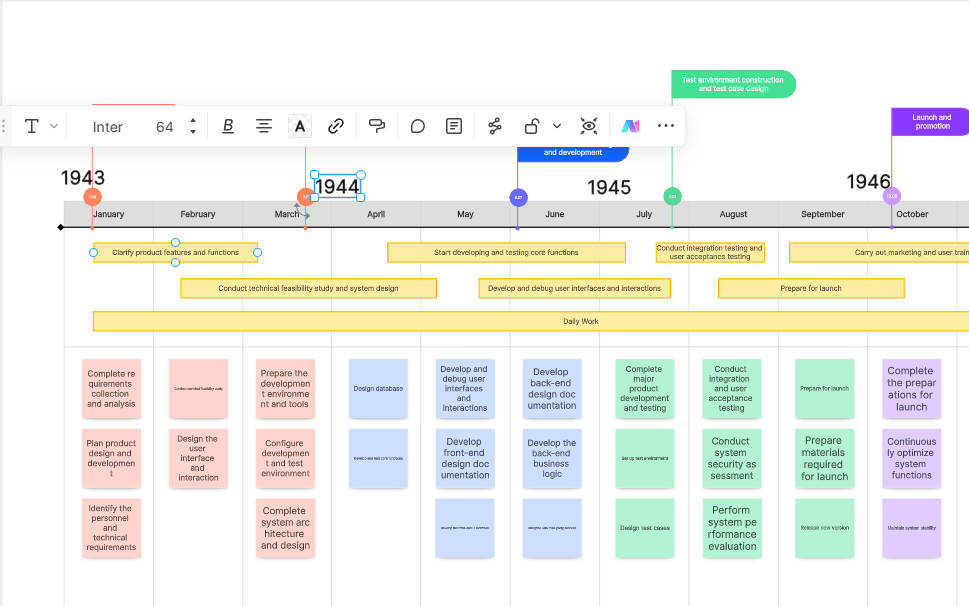
Step 3. Customization
Use Boardmix's various customization features to make your timeline stand out. You can add images, change colors and fonts, and even insert links and videos.
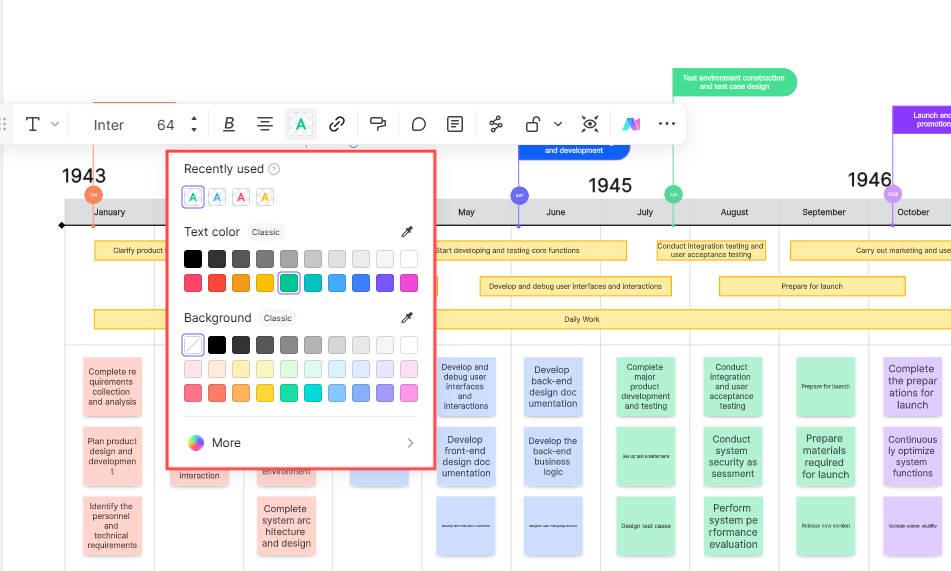
Step 4. Review
Carefully review your timeline to make sure there are no errors and that all events are represented correctly.
Step 5. Publishing and Sharing
Once you're happy with your timeline, you can publish it to the web or share it directly with your team or audience.
Remember, when using Boardmix to design your timeline, it's important to maintain a balance between complexity and explosiveness in your writing. Vary the length and structure of your sentences to keep readers engaged and interested.
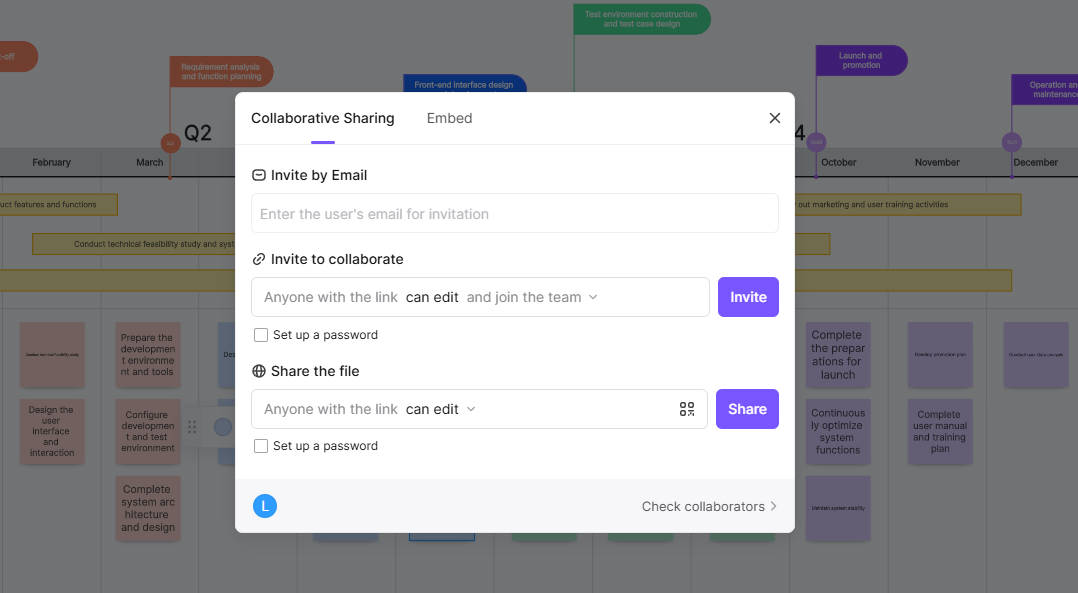
Tools to Create a History Timeline
In addition to Boardmix, you can also use traditional tools such as Microsoft software to create a timeline.
For a complete guide to creating a timeline in PowerPoint, see How to Create a Graphic Timeline in PowerPoint: A Complete Guide
To learn more about the steps to create a timeline in Word, see How to Create a Timeline in Word - Full Tutorial
Explore Useful History Timeline Examples
Let’s explore some insightful history timeline examples to uncover key milestones shaping the world, a nation, and the technology industry.
Example 1: The World History Timeline
3500 BCE - First known cities emerge in Mesopotamia.
2560 BCE - The Great Pyramid of Giza is completed in Egypt.
476 CE - The fall of the Western Roman Empire marks the beginning of the Middle Ages.
1492 CE - Christopher Columbus discovers the Americas.
1914-1918 CE - World War I reshapes global politics.
1969 CE - First humans land on the Moon (Apollo 11 mission).
1991 CE - End of the Cold War with the dissolution of the Soviet Union.
The World History Timeline highlights humanity's key milestones, from the rise of ancient cities to groundbreaking achievements like the Moon landing. It covers pivotal events such as the fall of the Roman Empire, global exploration, and significant wars, offering a snapshot of our shared global journey.
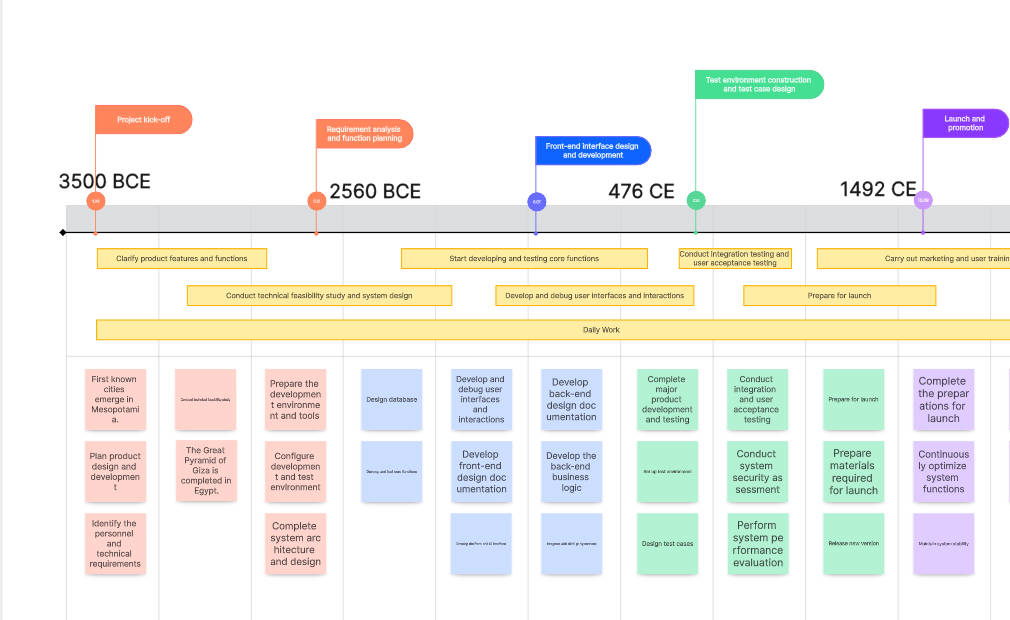
Create the world history timeline on Boardmix
Example 2: The US History Timeline
1492 - Christopher Columbus reaches the Americas.
1776 - Declaration of Independence is signed.
1861-1865 - American Civil War leads to the abolition of slavery.
1920 - Women gain the right to vote (19th Amendment).
1963 - Martin Luther King Jr. delivers the "I Have a Dream" speech.
1969 - Apollo 11 Moon landing includes Neil Armstrong, an American astronaut.
2008 - Barack Obama becomes the first African-American US President.
The US History Timeline showcases defining moments in American history, from independence to civil rights milestones. It spans events like the Declaration of Independence, the Civil War, and the Moon landing, reflecting the nation's evolving identity and major contributions to global progress.

Create the US history timeline on Boardmix
Example 3: The Google Development History Timeline
1998 - Google is officially founded by Larry Page and Sergey Brin.
2000 - Google launches its AdWords advertising platform.
2004 - Google goes public and introduces Gmail.
2006 - Google acquires YouTube, expanding into video content.
2015 - Google restructures under Alphabet Inc. as its parent company.
2019 - Google achieves quantum supremacy with its Sycamore processor.
2023 - Google unveils Bard, an AI-powered chatbot competing with ChatGPT.
The Google Development Timeline charts the company's rise from a search engine startup to a global tech leader. Key moments include the launch of Gmail, the acquisition of YouTube, and the introduction of AI tools like Bard, showcasing Google's innovation and global impact.
These history timelines simplify complex stories, offering a clear view of impactful moments that shaped the past and inspired the future.
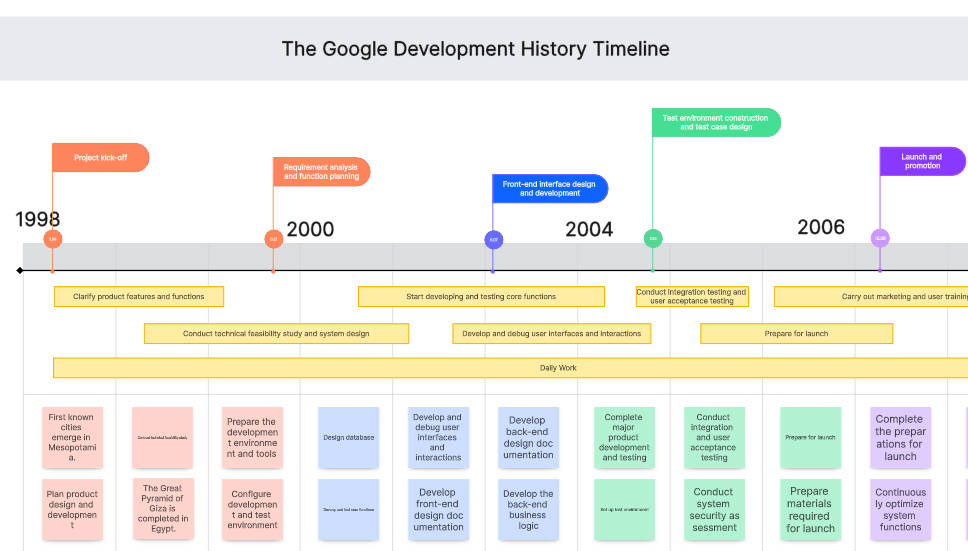
Create the Google development history timeline on Boardmix
The Timeline in the Digital Age
With the advent of the digital age, timelines have become more dynamic and accessible. In this new era, timelines are no longer mere static representations of the past, but have been transformed into interactive and living tools. Now, every historical event, every milestone, and every moment is presented with a wealth of detail and context never before possible.
Digitization has allowed these timelines to be much more than a linear succession of events. They have become true ecosystems of information, where every point can be explored to discover additional layers of meaning and connection. You can dive into a specific event to understand not only when it happened, but also why it happened, how it influenced future events, and how it intertwines with other moments in history.
Furthermore, the accessibility to these digital timelines is unparalleled. Before, one had to search through libraries or archives to get a complete view of history. Now, with just a few clicks, you can travel back in time from the comfort of your own home. And not only that, but you can also contribute to these timelines, adding your own perspective and information.
But perhaps what is most exciting is how these digital timelines are changing our relationship with the past. We are no longer mere spectators of history; we are active participants. We can interact with the past, question it, learn from it, and use it.
to inform our present and future.
So yes, timelines in the digital age are more dynamic and accessible. But they are also deeper, more interconnected, and more personal. They are a vibrant and ever-changing reflection of our collective understanding of the past, present, and future.
Conclusion
The timeline is an indispensable component in history education and continues to evolve to adapt to the changing needs of historical study. Although simple in conception, its value lies in its ability to visually represent and connect the various events and eras that make up our understanding of the past.
Therefore, understanding what a timeline is in history allows us to better appreciate how our world has developed and how events in our past have shaped our present day. On the other hand, Boardmix is a powerful and easy-to-use tool that can help you create effective and visually appealing history timelines. With a little planning and creativity, you can transform a boring list of dates and events into a dynamic and interesting visual narrative.









